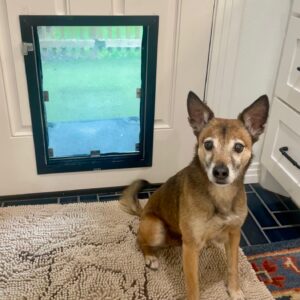Living with a dog is one of life’s more rewarding experiences. Our canine companions offer unconditional love, loyalty, and endless joy, but they also require thoughtful care and structure. Whether you’re a first-time dog owner or a seasoned pup parent, these expert tips from the WAGD staff will help you create a home that supports a balanced, happy life for both you and your dog.
1. Install a Doggie Door
Maureen Patin, CPDT-KA – Head Trainer
A doggie door can be a game-changer. Giving your dog access to an all-weather area of your yard allows them to relieve themselves as needed – no more rushing home or feeling guilty for leaving them too long.
Key Benefits:
- Convenience for both humans and dogs
- Reduces potty accidents and stress
- Keeps your floors clean if the outdoor surface is mud-free (try turf or gravel)
Safety Tip:
Ensure your yard is secure. Reinforce fences with underground barriers like hardware cloth, concrete, or spikes to prevent digging out. For small dogs or puppies, consider adding a cover to the yard to protect against predators like hawks or coyotes.
2. Manage Indoor Access
Charlotte Schuessler – Trainer
Set your house and routines up to encourage the behaviors you want, and prevent the ones you don’t. Block access to tempting zones like the kitchen, store shoes in closed closets, and exercise or train your dog before guests arrive. Dogs are creatures of habit; help them form good ones.
Aislinn Meeks – Trainer
 The best way to prevent the behaviors you don’t want to become habits is limiting your dog’s access in your home.
The best way to prevent the behaviors you don’t want to become habits is limiting your dog’s access in your home.
Baby gates, crates, and playpens (ex-pens) are lifesavers – especially in multi-dog households. These tools can:
- Speed up housetraining
- Reduce destruction
- Make mealtimes and training easier
- Keep things calm during high-stimulation times like guest visits
You can often find these tools secondhand at a low cost on Facebook Marketplace or similar platforms.

3. Prevent Counter Surfing
Sharon Lacaze – Operations Manager
Here’s a creative tip: use a portable table tennis net (with suction cups) to block areas of your counter where your dog tends to sneak snacks. This prevents your dog from being rewarded for bad behavior and gives you the chance to reward them for not jumping up—helping eliminate the habit altogether.
4. Use Window Clings to Reduce Reactivity

Fable Gay – Senior Trainer
If your dog gets anxious watching people or dogs pass by your windows, it could be contributing to your dog’s level of anxiety and their leash reactivity. Temporary window clings are a simple and affordable fix. Apply cling film (available online or at home stores) to the lower portion of traffic-facing windows to limit your dog’s visual triggers. Easy fix, big impact!
5. Monitor with Wi-Fi Cameras
Wi-Fi cameras are a budget-friendly way to keep tabs on your dog when you’re away. Whether you leave them free-roaming in your home, in a crate, or in a playpen, cameras help you:
Whether you leave them free-roaming in your home, in a crate, or in a playpen, cameras help you:
- Monitor their stress levels
- Catch signs of separation anxiety
- Spot destructive behavior before it escalates
If your dog is showing signs of distress while alone, consider working with a Certified Separation Anxiety Trainer for support.
Final Thoughts
Living with a dog isn’t just about caring for them, it’s about creating a partnership built on structure, communication, and mutual respect. By setting your home up for success, you lay the foundation for a harmonious life together.

